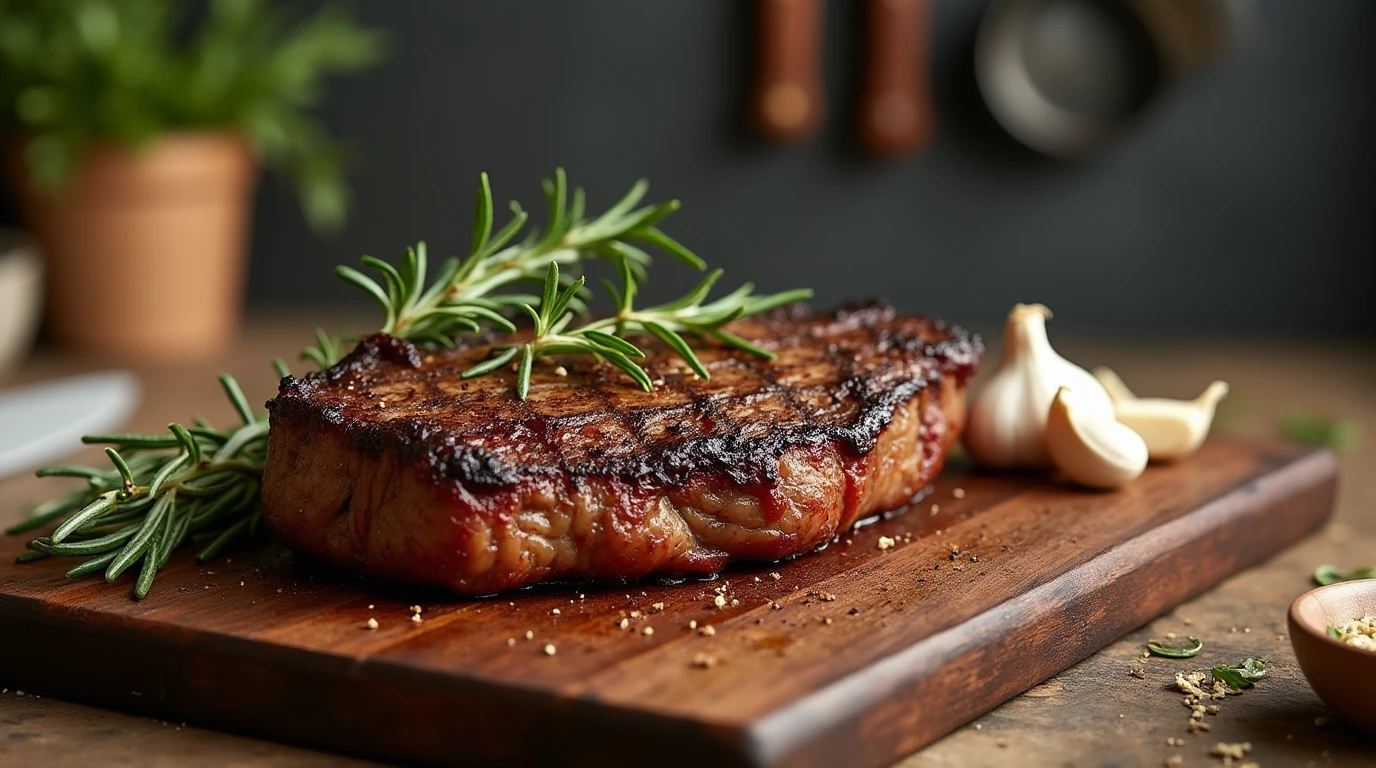Introduction
Delmonico steak is an iconic choice for beef enthusiasts. Known for its rich marbling, bold flavor, and tender texture, this steak has graced the plates of fine diners and home cooks alike. Not only that, but it also carries a rich culinary history that sets it apart from other cuts. Whether you’re a seasoned chef or a curious foodie, this guide will unravel everything you need to know about the legendary Delmonico steak.
What Is a Delmonico Steak?
The Delmonico steak, above all, is a term steeped in culinary history. Its origins trace back to Delmonico’s, a renowned 19th-century steakhouse in New York City. While the exact cut used back then remains debated, the term today generally refers to a tender, high-quality steak that could be a ribeye, strip loin, or even a boneless rib steak. In fact, the unifying factor among all variations is the promise of flavor and premium quality.
For instance, if you’re exploring different steak recipes, you might find inspiration in how to cut skirt steak or whether to braise skirt steak. These guides provide additional insights into beef preparation techniques.
Why Choose Delmonico Steak?
In addition to its rich flavor, the Delmonico steak offers a variety of benefits that make it a preferred choice:
- Superior Marbling: Provides exceptional tenderness and flavor.
- Versatile Preparation: Suitable for grilling, broiling, or pan-searing.
- Rich History: A name synonymous with culinary excellence.
Not only that, but Delmonico steak’s versatility makes it a standout option for experimenting with various cooking styles. For example, recipes for skirt steak preparation demonstrate how even alternative cuts can be elevated with proper techniques.
How to Choose the Best Delmonico Steak
Selecting the perfect steak starts with understanding quality indicators. In addition, knowing what to look for ensures the best results:
- Marbling: Look for fine streaks of intramuscular fat for optimal flavor.
- Color: Opt for bright red meat with no brown or gray spots.
- Thickness: Aim for steaks at least 1–1.5 inches thick for even cooking.
Moreover, selecting a high-quality cut ensures that the natural flavors of the meat shine through in any preparation.
How to Cook a Delmonico Steak

Cooking Delmonico steak requires mastering essential techniques. Consequently, following these steps will ensure steakhouse-quality results:
Ingredients
- 2 Delmonico steaks
- Kosher salt
- Freshly ground black pepper
- Olive oil or unsalted butter
- Fresh herbs (rosemary, thyme, or parsley)
- Optional: Garlic cloves
Preparation
- Seasoning: Pat the steak dry with paper towels. Generously season both sides with salt and pepper. Let it rest at room temperature for 30 minutes.
- Preheating: Preheat your grill, skillet, or oven to high heat. Above all, ensure the cooking surface is hot to achieve a perfect sear.
Cooking Techniques
Grilling
In contrast to other methods, grilling provides a smoky char:
- Sear Over High Heat: Grill the steak for 2–3 minutes per side for a beautiful crust.
- Move to Indirect Heat: Cook until the desired doneness is reached, using a meat thermometer for accuracy.
Pan-Searing
Similarly, pan-searing offers a caramelized crust:
- Use a Cast-Iron Skillet: Heat a skillet over high heat and add oil or butter.
- Sear Both Sides: Cook each side for 3–4 minutes.
- Finish in Oven: Transfer the skillet to a preheated oven at 400°F for 5–7 minutes.
Broiling
In short, broiling is ideal for quick, even cooking:
- Position the Rack: Set the oven rack 6 inches from the broiler.
- Cook Each Side: Broil the steak for 4–6 minutes per side, flipping once.
Additionally, mastering tools like a cast-iron skillet can significantly enhance your cooking results.
Creative Variations for Delmonico Steak
For example, you can try these flavorful options to elevate your dish:
- Garlic Herb Butter: Top the steak with a dollop of butter mixed with minced garlic, parsley, and chives.
- Balsamic Glaze: Drizzle balsamic reduction for a tangy twist.
- Chimichurri Sauce: Serve with a vibrant chimichurri made of parsley, garlic, and olive oil.
In addition, pairing the steak with unique sides like crispy burger toppings or lumache pasta creates a well-rounded meal.
The History of Gourmet Steaks
Delve into the fascinating story of gourmet steaks like Delmonico. From their origins in fine dining to their popularity among home cooks, these cuts have always represented premium quality. For instance, Delmonico’s legacy reflects its historical significance in shaping how we enjoy steak today. Similarly, understanding the evolution of steak cuts like ribeye and sirloin enhances our appreciation for this culinary art.
Top Tips for Preparing High-Quality Steaks
When it comes to preparing a gourmet steak, mastering the basics is essential. For example, seasoning techniques, cooking temperatures, and resting times can elevate your steak from average to exceptional. Additionally, tools like cast-iron skillets or meat thermometers are invaluable for achieving perfect doneness. As a result, understanding these elements ensures consistent and delicious results.
Pairing Steaks with Perfect Side Dishes
Choosing complementary sides for premium steaks, like a Delmonico cut, enhances the dining experience. For example, pairing creamy mashed potatoes, sautéed asparagus, or a fresh arugula salad balances the rich flavors of the steak. Moreover, creative options like roasted root vegetables or wild rice pilaf add depth and variety to your meal.
Creative Ways to Flavor Your Steak
Experimenting with flavors and seasonings can take your steak to the next level. For instance, marinades, rubs, and sauces offer endless possibilities for customization. Not only that, but adding toppings like herb butter, chimichurri, or a balsamic glaze can transform a simple steak into a gourmet dish. In addition, these enhancements allow you to tailor your meal to suit your personal taste.
Selecting the Finest Cuts of Beef

When choosing beef for a perfect steak dinner, the quality of the cut plays a vital role. For instance, understanding the differences between ribeye, tenderloin, and strip steak can guide you to the ideal selection for your recipe. Additionally, looking for well-marbled meat ensures a juicy and flavorful steak every time.
Mastering Cooking Techniques for Beef Steaks
Achieving a restaurant-quality steak at home requires precision and practice. For example, techniques such as pan-searing, grilling, and broiling all produce unique flavors and textures. Moreover, using tools like meat thermometers and cast-iron skillets can make a significant difference in your results.
The Role of Marinades and Rubs in Beef Preparation
Marinades and rubs are essential for enhancing the flavor of beef steaks. For instance, a simple blend of garlic, olive oil, and fresh herbs can add a burst of flavor. On the other hand, dry rubs with spices like smoked paprika and cayenne bring a smoky, bold taste to your dish.
Perfecting Steak Doneness for Every Preference
Understanding steak doneness levels is crucial for serving a crowd-pleasing meal. For example, rare steaks are prized for their tender texture, while medium-rare offers a balance of juiciness and firmness. In contrast, medium-well and well-done steaks cater to those who prefer a firmer bite.
Exploring Popular Cuts of Steak
Understanding the variety of steak cuts available can elevate your cooking game. For example, cuts like filet mignon, porterhouse, and sirloin each offer unique textures and flavors. In addition, learning how to choose the right cut for your dish ensures a more tailored and satisfying dining experience.
Seasoning Strategies for Flavorful Steaks
The key to a delicious steak lies in its seasoning. Not only does salt and pepper enhance the natural flavors, but additional ingredients like garlic, rosemary, and thyme can create a gourmet touch. Moreover, experimenting with spice blends or marinades can lead to exciting flavor profiles.
Cooking Essentials for Perfect Steak Preparation
Mastering the tools and techniques of steak preparation is essential for achieving the best results. For instance, using a preheated cast-iron skillet, ensuring proper heat distribution, and allowing the steak to rest are all critical steps. Additionally, monitoring cooking times ensures the perfect level of doneness.
Steak Pairings: Sauces and Toppings
The right sauce or topping can transform a simple steak into a memorable dish. For example, options like blue cheese butter, mushroom cream sauce, or red wine reduction add depth and richness. On the other hand, lighter toppings like herb chimichurri provide a fresh and zesty contrast.
Understanding Beef Grades for Better Steaks
Knowing the grades of beef can help you select the highest-quality steaks for your meal. For example, USDA Prime, Choice, and Select each offer different levels of marbling and tenderness. In addition, understanding these grades ensures you make informed choices at the butcher or grocery store.
Perfecting Sear Techniques for Beef Steaks
Achieving a golden, caramelized crust on your steak is an essential skill. For instance, preheating your skillet to a high temperature and using the right amount of fat can create that perfect sear. Additionally, flipping the steak at the right moment ensures even cooking and enhances the overall flavor.
Innovative Steak Garnishes to Elevate Your Dish
Steak garnishes can take your dish to the next level by adding both visual appeal and flavor. For example, crispy onion strings, grilled lemon slices, or fresh microgreens complement the richness of the beef. On the other hand, bold choices like truffle shavings or balsamic glaze offer a luxurious finish.
Common Mistakes to Avoid When Cooking Steaks
Cooking steak to perfection requires avoiding common pitfalls. For instance, skipping the resting stage can lead to dry meat, while overcooking diminishes its tenderness. Moreover, not seasoning adequately or using low-quality tools can impact the final dish.
FAQs
- What is the difference between ribeye and Delmonico steaks?
In contrast to ribeye, Delmonico is a broader term encompassing various cuts. Ribeye specifically refers to the rib section, known for marbling. - What sides pair well with Delmonico steak?
Above all, classic sides like mashed potatoes, grilled asparagus, creamed spinach, or a fresh arugula salad are perfect companions.
Conclusion
In conclusion, Delmonico steak remains a timeless choice for steak enthusiasts. Moreover, its versatility and rich flavors make it a culinary delight. By selecting quality cuts, mastering cooking techniques, and exploring creative variations, you can enjoy restaurant-quality steak in the comfort of your home.
Finally, to expand your culinary repertoire, explore more recipes and techniques on Recipes Rania. For example, learn about the rich history of Delmonico’s restaurant and discover perfect steak doneness tips. As a result, your culinary skills will elevate to new heights.

